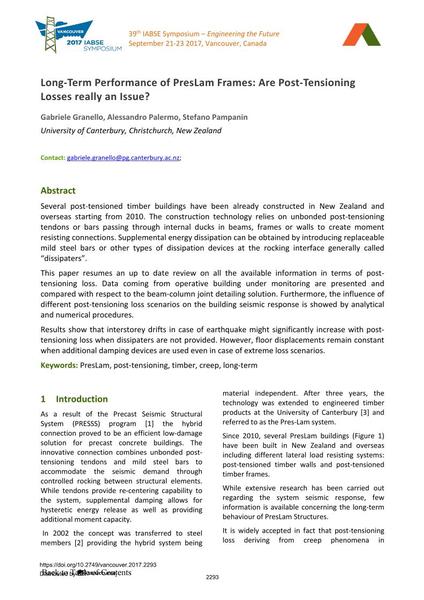Long-Term Performance of PresLam Frames: Are Post-Tensioning Losses really an Issue?

|
|
|||||||||||
Bibliografische Angaben
| Autor(en): |
Gabriele Granello
(University of Canterbury, Christchurch, New Zealand)
Alessandro Palermo (University of Canterbury, Christchurch, New Zealand) Stefano Pampanin (University of Canterbury, Christchurch, New Zealand) |
||||
|---|---|---|---|---|---|
| Medium: | Tagungsbeitrag | ||||
| Sprache(n): | Englisch | ||||
| Tagung: | IABSE Symposium: Engineering the Future, Vancouver, Canada, 21-23 September 2017 | ||||
| Veröffentlicht in: | IABSE Symposium Vancouver 2017 | ||||
|
|||||
| Seite(n): | 2293-2300 | ||||
| Anzahl der Seiten (im PDF): | 8 | ||||
| Jahr: | 2017 | ||||
| DOI: | 10.2749/vancouver.2017.2293 | ||||
| Abstrakt: |
Several post-tensioned timber buildings have been already constructed in New Zealand and overseas starting from 2010. The construction technology relies on unbonded post-tensioning tendons or bars passing through internal ducks in beams, frames or walls to create moment resisting connections. Supplemental energy dissipation can be obtained by introducing replaceable mild steel bars or other types of dissipation devices at the rocking interface generally called “dissipaters”. This paper resumes an up to date review on all the available information in terms of post- tensioning loss. Data coming from operative building under monitoring are presented and compared with respect to the beam-column joint detailing solution. Furthermore, the influence of different post-tensioning loss scenarios on the building seismic response is showed by analytical and numerical procedures. Results show that interstorey drifts in case of earthquake might significantly increase with post- tensioning loss when dissipaters are not provided. However, floor displacements remain constant when additional damping devices are used even in case of extreme loss scenarios. |
||||
